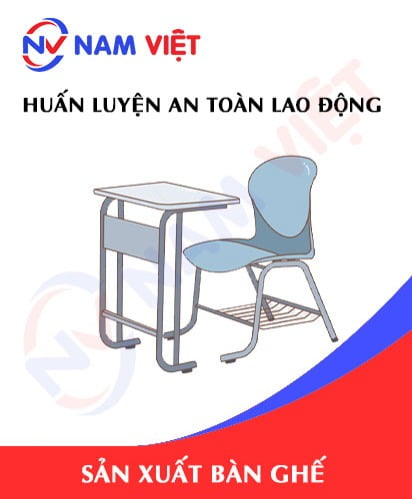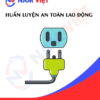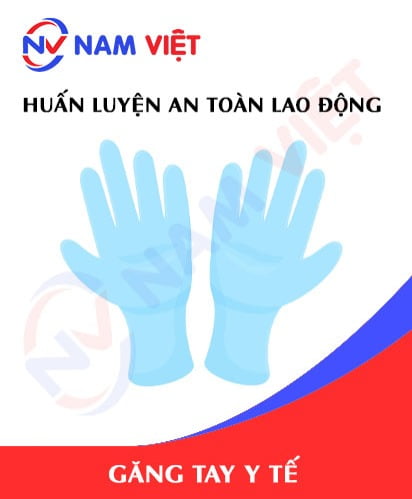Occupational safety training for chair and table manufacturing
99,000 ₫
Note: The above price is calculated per person and may vary depending on the number of trainees participating in the course and market fluctuations. For more accurate pricing support, please refer to the quotation or contact our consultants directly.
Occupational safety is an important issue in chair and table manufacturing factories and needs to be addressed promptly to ensure the health and safety of workers, while enhancing the reputation of businesses. The Occupational Safety Training course is an effective solution to raise awareness about accident prevention for workers involved in chair and table manufacturing.
Table of Contents
Toggle1. Overview of chairs and tables
a. What are chairs and tables?
- Chairs and tables are types of furniture used for sitting, working, studying, or eating. Chairs and tables are often made from materials such as wood, metal, plastic, or even glass.
- A table is often designed with a flat tabletop for placing documents or objects and legs to keep the table stable. Its height can be adjusted depending on the needs of use. Tables are often used in classrooms, offices, or dining areas.
- A chair is a type of furniture designed for sitting. Chairs can be made from various materials, including wood, metal, plastic, and even leather. Chairs are often designed with a backrest and a seat for the user to sit comfortably. Chairs can be used in living rooms, dining rooms, classrooms, or work areas.

b. Types of chair and table manufacturing machinery
Types of chair and table manufacturing machinery include:
- Table saw: used to cut wood into different sizes and shapes.
- Grinding machine: used to grind wooden details into different shapes.
- Pressing machine: used to press wooden details together to form larger parts of the chairs and tables.
- Polishing machine: used to polish the wooden details of the chairs and tables.
- Metal cutting and bending machine: used to cut and bend the metal details of the chairs and tables.
- Metal welding machine: used to weld the metal details of the chairs and tables together.
- Sewing machine: used to sew chair cushions or decorative fabric.
- Drilling machine: used to drill holes in the wooden or metal parts of the chairs and tables.
- Trimming machine: used to cut and trim materials such as leather or fabric for the cushions of the chairs and tables.
These types of machinery are often used in the manufacturing process of the parts and components of chairs and tables to create the finished product. There are also other types of machinery that serve the chair and table manufacturing process.

c. Typical chair and table manufacturing businesses
Here are some typical chair and table manufacturing businesses in Vietnam:
- Hoa Phat Group: A leading multi-industry group in Vietnam, manufacturing and trading steel products and wood products such as chairs and tables.
- Binh Minh Joint Stock Company: One of the leading businesses in Vietnam in manufacturing wooden furniture products, including chairs and tables, cabinets, beds, dressing tables, etc.
- Moc Xua Single Member Co., Ltd: A business that manufactures chairs, tables, and furniture products from natural wood.
- Tai Nguyen Joint Stock Company: A business that manufactures chairs, tables, cabinets, beds, etc. from industrial wood, established in 1993.
- Duong Gia Joint Stock Company: One of the leading businesses in Vietnam in chair and table manufacturing, with a variety of products from living room chairs and tables, dining tables and chairs, office chairs, etc.
- Hung Nguyen Trading and Service Co., Ltd: One of the businesses specializing in manufacturing and supplying wooden furniture products, including chairs and tables, cabinets, beds, etc. for the domestic and international markets.
- Kymdan Joint Stock Company: A business that manufactures high-end furniture products from natural rubber and wood, including chairs, tables, beds, cabinets, etc.
d. Common materials used for chair and table manufacturing
The main materials used to manufacture chairs and tables include:
- Wood: Wood is the most common material used to manufacture chairs and tables, because it has high durability and aesthetics. The most common types of wood used to manufacture chairs and tables are oak, rubberwood, melaleuca, pine, dorian, etc.
- Metal: Metal, such as steel and aluminum, is used to manufacture chair frames or small details such as chair legs. Metal has high durability and is easy to design into complex shapes.
- Plastic: Plastic is a common material used to manufacture plastic chairs, plastic-covered chairs, or molded plastic chairs. Plastic has high durability and elasticity, and it is also easy to manufacture and maintain.
- Fabric: Fabric is used to cover chair cushions or to make mattresses. Common types of fabrics used to manufacture chairs and tables include linen, velvet, felt, canvas, etc.
- Leather: Leather is a high-end material used to cover chair cushions or to make mattresses. Leather has high durability and aesthetics, and it can be used to create luxurious products.

e. Specific jobs in a chair and table manufacturing factory
Group 1
- Executive director, deputy executive director, department head in a chair and table manufacturing factory.
Group 2
- Safety officer: manages safety in the factory, designs safety procedures, supervises and urges employees to comply with safe work procedures.
Group 3
- Raw material preparation: This is the most important step in the chair and table manufacturing process. The main raw materials are wood, cushioning materials, fabric, accessories, and other parts.
- Wood pre-processing: Wood needs to be pre-processed before being used to manufacture chairs and tables. This process includes removing uneven parts on the wood surface and protecting the wood from environmental factors such as water, termites, and mold.
- Cutting wood and metal: After being pre-processed, the wood will be cut to the required size and shape to create the parts of the chairs and tables, such as legs, backrests, cushions, etc. In addition to wood, metal is often used to make the legs or frames of tables and chairs.
- Joining and assembly: After being cut, the parts of the chairs and tables will be joined and assembled together. This process includes tasks such as drilling, screwing, gluing, etc.
- Polishing and finishing: After the parts are assembled, the chairs and tables will be polished and finished. This process includes painting or applying a protective layer on the surface, to protect the chairs and tables from environmental factors such as water, termites, and mold.
- Quality control: Before being put on the market, the parts and finished products will be checked for quality to ensure that they meet the quality and safety standards for the user.
Group 4
- Office jobs, serving, sales, marketing.
- Manufacturing management, quality management, human resource management, material management, financial accounting management.
- Research and development of new products, designing product packaging.
2. Overview of the occupational safety training course for chair and table manufacturing
Within the scope of this article, we focus on the issues surrounding Group 3, because Group 3 is the group directly involved in the manufacturing process, bearing the highest risk of occupational accidents. Refer to other groups here
a. What is Group 3 occupational safety training?
- Occupational safety training for Group 3 are training sessions that equip workers with the awareness of how to prevent occupational accidents.
- The occupational safety training course will help workers recognize and prevent dangers, and limit the risks of occupational accidents during work.
REGISTER FOR OCCUPATIONAL SAFETY TRAINING SERVICE
b. Training duration
First-time safety training duration
- Total training duration is at least 24 hours, including the test time.
- 8 hours of theoretical study on the system of policies and laws on occupational safety and health
- 8 hours of theoretical study on basic knowledge of occupational safety and health
- 4 hours of theoretical study on specialized training content
- 2 hours of practical training on specialized training content
- 2 hours of theoretical examination at the end of the training course
The safety training center will allocate the time into multiple training sessions depending on the time arrangement for the employees. However, there will usually be 6 training sessions, and the course will take place over 3 days, provided that the manufacturing business can arrange continuous study time.
Periodic safety training duration
- Before the occupational safety card expires, if an employee wants to get a renewal, they must undergo a periodic occupational safety training course, with the periodic safety training duration being at least 50% of the first-time safety training duration.
Explanation: The total periodic occupational safety training duration is at least 12 hours, including the test time. After completing the periodic training course and passing the test, the employee will be re-issued or have their occupational safety card renewed.
c. Content of the training course
| No. | TRAINING CONTENT | TRAINING DURATION (HOURS) | |||
| Total | Of which | ||||
| Theory | Practical | Test | |||
| I | System of policies and laws on occupational safety and health | 8 | 8 | 0 | 0 |
| 1 | Overview of the system of legal normative documents on occupational safety and health. | 6 | 6 | ||
| 2 | System of technical standards and regulations on occupational safety and health. | 1 | 1 | ||
| 3 | Specific regulations of state management agencies on occupational safety and health when constructing, expanding or renovating works, facilities for manufacturing, using, preserving, storing and inspecting machinery, equipment, materials, and substances with strict requirements on occupational safety and health. | 1 | 1 | ||
| II | Basic knowledge of occupational safety and health | 8 | 8 | 0 | 0 |
| 1 | Basic knowledge of dangerous and harmful factors at the workplace. | 4 | 4 | ||
| 2 | Methods for improving working conditions. | 1 | 1 | ||
| 3 | Safety culture in manufacturing and business. | 1 | 1 | ||
| 4 | Rights and obligations of employers and employees; policies and regimes on occupational safety and health for employees; functions and duties of the occupational safety and health network. | 1 | 1 | ||
| 5 | Occupational safety and health regulations, signs, occupational safety and health instructions, and the use of safety equipment, personal protective equipment; first aid skills for occupational accidents, prevention of occupational diseases. | 1 | 1 | ||
| III | Specialized training content | 6 | 4 | 2 | 0 |
| General knowledge of types of machinery, equipment, substances that generate dangerous and harmful factors; analysis, assessment, management of occupational safety and health risks, safe work procedures with machinery, equipment, and substances with strict requirements on occupational safety and health. | 6 | 4 | 2 | ||
| IV | Occupational safety training test at the end of the training course | 2 | 2 | 0 | 0 |
| Total | 24 | 22 | 2 | ||
See more training content of the 6 groups
d. Occupational safety card
After completing the occupational safety training course and passing the test, the employee will be issued an occupational safety card (commonly referred to as a Group 3 occupational safety certificate).
The Group 3 safety card will clearly show information such as: full name, date of birth, specific job, and work environment. It will also include the training duration, a red stamp, and a signature confirming the completion of the training course.
According to the regulations on issuing safety cards specified in Clause 2 of Article 24 of Decree 44/2016/ND-CP, there are two cases:
- In the case where the employer and the employee have a labor contract, the employer must sign, stamp, and seal the safety card for the Group 3 trainee after they have undergone the training course from the occupational safety training unit and passed the test.
- In the case of freelance or seasonal workers who do not have a labor contract, the training unit must sign, stamp, and seal the safety card for the employee after they have undergone the training course from the occupational safety training unit and passed the test.

3. Identifying dangers in chair and table manufacturing
During the chair and table manufacturing process, there are a number of potential dangers that can cause occupational accidents or affect the health of workers. Here are some of the main dangers to be aware of:
- Chair and table manufacturing often uses powerful motorized machinery, cutting blades, and other moving parts, which can cause serious accidents if safety procedures are not followed during use.
- Chair and table manufacturing uses materials that can pose a danger to workers, such as fiberglass, wood dust, chemicals, etc. If personal protective measures are not used, these materials can affect the health of workers.
- Some chair and table manufacturing processes use toxic chemicals or gases such as formaldehyde, sky blue, etc. If workers do not wear a mask or use appropriate protective equipment, they can inhale these toxic gases and harm their health.
- Chair and table manufacturing often uses liquids such as grease or cleaning solutions. If appropriate protective equipment is not used, these liquids can cause skin irritation, vomiting, or burns.
- Improper work operations such as painting, coating, nailing, etc. can cause serious occupational accidents or cause injuries to workers.
4. Common occupational accidents in chair and table manufacturing
During the chair and table manufacturing process, occupational accidents can occur, including:
- Accidents caused by machinery: The machinery in the manufacturing process can cause collisions, cuts, crushing, pulling, and tearing of skin on hands, legs, or other injuries.
- Accidents caused by materials: Wood, metal, or plastic materials during cutting, drilling, and nailing can cause accidents such as eye injuries, cuts, tearing of skin on hands, legs, and arms.
- Accidents caused by manual operations: Workers often have to use their hands to cut, nail, or paint parts of the chairs and tables, so accidents such as being cut, stabbed, or injured by paint can occur.
- Accidents due to improper manufacturing procedures: When workers do not follow the correct manufacturing procedures, such as not using full protective equipment, working in dangerous environments, or not using safe tools, accidents such as falling, tripping, being trapped by objects, or losing balance while working on equipment can occur.
- Accidents due to the work environment: The chair and table manufacturing factory can cause accidents due to the work environment such as being affected by dust, smoke, chemicals, or noise, leading to health problems such as difficulty breathing, headaches, lack of sleep, and reduced concentration.
5. Safety measures when participating in chair and table manufacturing
Safety measures when participating in chair and table manufacturing include:
- Employees must wear full personal protective equipment such as safety glasses, masks, gloves, and anti-nail shoes to protect their eyes, ears, nose, mouth, hands, and feet.
- Ensure that machine protective devices such as safety doors, emergency switches, automatic stop machines when an incident occurs, and signal lights are installed so that employees can detect and handle them in a timely manner.
- Employees need to be trained to use machinery and equipment correctly, follow safety procedures, usage instructions, and check before use.
- Regularly check and maintain machinery to ensure safety during use. If an incident is detected, it must be fixed in a timely manner.
- Install and transport products according to safe procedures, ensuring no incidents or dangers occur during transportation and installation.
- Ensure that there is sufficient fire prevention and fighting equipment, an incident response plan, and training for employees on fire prevention and fighting measures.
- Organize occupational safety and health training for employees, and raise their awareness of occupational safety, ensuring that employees understand safety regulations and have the necessary skills to prevent occupational accidents.
- Periodically organize work environment monitoring in factories and enterprises, collect and analyze harmful factors to workers, and then adjust to reduce the level of harm to prevent occupational diseases for them.

6. Benefits of occupational safety training in chair and table manufacturing
An Toan Nam Viet provides businesses with excellent benefits after completing occupational safety training courses as regulated in Decree 44/2016/ND – CP on occupational safety and health, for companies, enterprises, and factories.
- Employees can recognize the potential risks of occupational accidents and then have preventive measures to avoid them.
- Your business can establish risk prevention measures in the manufacturing, operation, and maintenance processes.
- Reduce costs when safety risks occur in the workplace.
- Uninterrupted manufacturing will help increase labor productivity and product quality.
- Comply with occupational safety laws, avoiding legal risks.
- Create a reputation and professionalism in all aspects, thereby elevating your business’s brand.
An Toan Nam Viet’s training courses are a solution to prevent and combat external factors affecting individuals so they can avoid dangers that can lead to injury or, more seriously, death.
REGISTER FOR OCCUPATIONAL SAFETY TRAINING SERVICE
7. Customer feedback after completing the occupational safety training course for chair and table manufacturing
An Toan Nam Viet has many years of experience in its mission to accompany many businesses in Vietnam in general and in the southern provinces in particular. And that responsibility is something very valuable to An Toan Nam Viet, which is why our Occupational Safety Training is increasingly professional. And the motivation for An Toan Nam Viet’s strong development comes from the positive feedback and suggestions from the businesses we have served. Below are the testimonials from our valued partners.
Bac Nam E&C Investment and Construction Joint Stock Company
“The first time I used the service at An Toan Nam Viet, I was very surprised by the enthusiastic 24/7 support from the consulting team. The class organization was very quick and convenient for our company, thank you very much for An Toan Nam Viet’s service!”
Hoa Dat Construction and Trading Joint Stock Company
“An Toan Nam Viet’s service has helped us a lot in simplifying occupational safety and completing safety records for our work process. The consulting team is enthusiastic and timely in answering our questions. 5 stars for An Toan Nam Viet.”
See more customer interviews after using An Toan Nam Viet’s service
8. An Toan Nam Viet’s occupational safety training capability
An Toan Nam Viet is a reputable and high-quality occupational safety training center in Vietnam today. With continuous occupational safety training sessions taking place at manufacturing workshops, factories or construction sites across the country (all 63 provinces and cities in Vietnam).
REGISTER FOR OCCUPATIONAL SAFETY TRAINING SERVICE
Occupational safety training license
- An Toan Nam Viet has been inspected and certified by the Safety Bureau of the Ministry of Labor – Invalids and Social Affairs as qualified to operate occupational safety and health training. This further strengthens our capacity in occupational safety training.

Training materials and lectures
- Before occupational safety training materials are used in occupational safety training courses, they are reviewed and approved to ensure that the lectures are factually correct and effective when applied.
- The teaching method of our instructors is standardized according to An Toan Nam Viet‘s teaching standards, which is a method that experts in occupational safety and health training have researched and refined during their teaching to bring the highest knowledge absorption efficiency to trainees.
Facilities
- Controlling the factors in the classroom that affect the training process will increase teaching performance and the effectiveness of student knowledge absorption.
- Our training support facilities always provide spacious classrooms that meet standards for area, lighting, training equipment, etc.
9. Reputable and quality nationwide safety training center
At An Toan Nam Viet, we always prioritize our professional dedication to occupational safety training. For us, imparting the knowledge of self-protection to workers so they have a safe foundation on their livelihood path is contributing to building the country.
To ensure effective training, we meticulously and carefully prepare every small detail. From preparing teaching tools, equipment, and devices to textbooks, materials, sound, and lighting.
Our occupational safety training instructors are experts with many years of experience in the field. They even have research projects identifying dangers in all occupations and how to prevent them.
The instructors’ lectures are distilled from real-world practice and are conveyed in the most vivid and easy-to-visualize way for workers. These factors help workers feel comfortable during their study time and absorb our taught knowledge well. Of course, the knowledge conveyed always closely follows Decree 44/2016/ND-CP.
From there, they grasp many measures to prevent dangers and how to protect themselves. At the same time, they can apply it in the most appropriate way in their actual work.
Our safety training center is proud to be a reputable and professional provider of occupational safety training services with the following advantages:
- Competitive training costs but training quality is still guaranteed.
- Lich organized training is flexible with the production situation of the company.
- Fast and legally compliant procedures for issuing occupational safety training certificates.
- Training instructors are highly experienced professionals with many years in the field.
- The classroom environment is controlled for factors that affect the training process, increasing teaching efficiency and student knowledge absorption.
- The lectures are compiled to be suitable for occupational safety work at businesses.
- An Toan Nam Viet works with dedication and professionalism to support customers accurately and as quickly as possible.

10. See more occupational safety training documents for table and chair manufacturing
- Occupational safety documents for table and chair manufacturing
- Set of occupational safety training documents
- Set of occupational safety training test questions
- Multiple-choice test for occupational safety in table and chair manufacturing
- Slides for occupational safety training lecture on table and chair manufacturing
1 review for Occupational safety training for chair and table manufacturing
No comments yet















namchinh.haiphong341
Lớp học được tổ chức rất bài bản